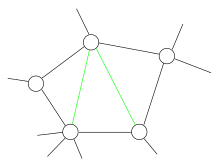
Back কর্ডাল গ্রাফ Bengali/Bangla Chordální graf Czech Chordaler Graph German Kordeca grafeo Esperanto گراف وتری Persian Graphe cordal French גרף מיתרי HE Merev körű gráf Hungarian Grafo cordale Italian 弦グラフ Japanese

In the mathematical area of graph theory, a chordal graph is one in which all cycles of four or more vertices have a chord, which is an edge that is not part of the cycle but connects two vertices of the cycle. Equivalently, every induced cycle in the graph should have exactly three vertices. The chordal graphs may also be characterized as the graphs that have perfect elimination orderings, as the graphs in which each minimal separator is a clique, and as the intersection graphs of subtrees of a tree. They are sometimes also called rigid circuit graphs[1] or triangulated graphs:[2] a chordal completion of a graph is typically called a triangulation of that graph.
Chordal graphs are a subset of the perfect graphs. They may be recognized in linear time, and several problems that are hard on other classes of graphs such as graph coloring may be solved in polynomial time when the input is chordal. The treewidth of an arbitrary graph may be characterized by the size of the cliques in the chordal graphs that contain it.
© MMXXIII Rich X Search. We shall prevail. All rights reserved. Rich X Search